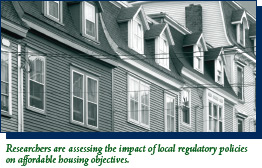November 2009
In this Issue
Paying for Energy Infrastructure Upgrades
Powered by the Sun
The Health of Our Cities’ Housing
Reevaluating Affordable Housing Policy Tools
In the next issue of ResearchWorks
Reevaluating Affordable Housing Policy Tools
In recent decades, states and localities have turned to a number of regulatory tools — such as smart growth policies, inclusionary zoning (IZ), in-lieu fees for developers, density bonuses, and land use regulations — to expand their stock of affordable housing. For decades, HUD has been a leader in addressing barriers to affordable housing through our research and development efforts, and the latest Cityscape symposium continues this tradition by examining some of the most innovative and popular affordable housing policy tools.1 The following synopsis of symposium articles shows how researchers are exploring the impact of these tools on consumers and local economies.

The lead article, “Housing Market Effects of Inclusionary Zoning” by Antonio Bento, Scott Lowe, Gerrit-Jan Knaap, and Arnab Chakraborty, examines the effects of IZ policies on housing prices and starts in California from 1988 to 2005. Adopted to counter the exclusionary zoning once commonly used to keep low-cost housing out of a locality, IZ mandates that a specified share of new residential construction be affordable to low- and moderate-income families. The study found, within the context of the superheated housing market of the 1990s, that IZ boosted the supply of multifamily housing by 7 percent, but increased housing prices 2 to 3 percent faster than in comparable locales. Housing price effects were greater in higher-priced markets, suggesting that builders of single-family units passed on the increase in building costs to home-buyers, especially in higher-end markets. Finally, researchers learned that the size of market-rate houses in cities with IZ grew more slowly, with reduced square footage in less expensive units.
Many communities structure IZ to provide alternatives for residential developers who would otherwise be required to include a set allotment of housing priced below market rate within the confines of market-priced projects. In “Evaluation of In-Lieu Fees and Offsite Construction as Incentives for Affordable Housing Production,” Douglas R. Porter and Elizabeth B. Davison examine two such practices. One allows developers of market projects to build the required affordable houses offsite; the other allows them to pay an in-lieu fee to a housing nonprofit or trust fund, which then applies the money toward affordable housing construction at a site of their choosing. The authors studied three communities that instituted these alternatives — Boulder, Colorado; Montgomery County, Maryland; and Pasadena, California. In-lieu fees/offsite options worked well in enabling two of the communities to “produce affordable units in satisfactory locations” while mitigating developer costs. In the third community, however, a perceived lack of transparency in setting fees politicized the program, and the ensuing controversy made in-lieu fees unacceptable to local officials.
Can the adverse effects of excessive local land-use regulatory barriers be remedied? In “Removing Regulatory Barriers to Affordable Housing in Development Standards, Density Bonuses, and Processing of Permits in Hillsborough County, Florida,” Sam Casella and Stuart Meck describe a recommended regulatory makeover, (which has subsequently been approved), based on an assessment of the county’s comprehensive plan, land development code, building code, development review process, and interviews with the county’s Affordable Housing Office. The authors focused on three issues: county development standards, such as minimum lot size or housing setbacks that can arbitrarily increase housing prices; the use of a density bonus designed to override code limits on the number and size of houses on a given parcel to realize affordable housing benefits; and the processing of development and building permits, considered a source of uncertainty and delay by homebuilders in many localities. Problems were traced to an elaborate rezoning procedure, narrow targeting of only large-scale developments, and stringent criteria for approval — such as the presence of substandard housing, resident households with low or moderate incomes and proximity to an economic development area that provides employment. The analysis concluded that the county would benefit from substantial downsizing of setbacks and lots, as well as from modifying density bonuses, simplifying permitting, and accelerating development reviews.
The final article, "Urban Sprawl and the Transition to First-Time Homeownership," shifts the focus to smart growth policies. Casey J. Dawkins challenges the conventional wisdom that “sprawl creates a mismatch between jobs and housing, leads to ineffective transportation systems, and restricts housing choice.” Instead, the author observes that "sprawl actually enhances housing opportunities, particularly for low-income working minorities who make the transition from renters to first-time homebuyers." Dawkins used data from the Panel Study on Income Dynamics (waves 1978 through 1997) matched to U.S. Census data to explore first-time homeownership transition. The sample tended to be younger, nonwhite, and to "belong to single-parent family or nonfamily households with a combined household income of about $12,000 less than that of other recent homebuyers." Measures of sprawl — density of urban settlement, local government fragmentation, and the presence of regional urban growth boundaries (UGBs) intended to contain growth inside an urbanized parameter — indicated "for the average renter in the sample, first-time homeownership occurs sooner in areas with lower urban densities, increased local government fragmentation, and in the presence of a UGB."
The research shared in this symposium can help communities assess their own policies and find ways to further their affordable housing objectives. Other resources available from HUD USER include the Regulatory Barriers Clearinghouse (www.regbarriers.org) and a previous Cityscape that focuses on regulatory barriers to affordable housing (Volume 8, Number 1 at www.huduser.gov/periodicals/cityscpe/vol8num1/index.html).
1This issue of Cityscape (Volume 11, Number 2) can be downloaded at www.huduser.gov/periodicals/cityscpe/vol11num2/index.html. Print copies can be ordered by calling HUD USER at 800.245.2691, option 1.

